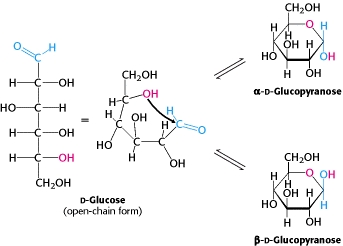Glucose: Difference between revisions
No edit summary |
No edit summary |
||
| Line 1: | Line 1: | ||
Glucose is a [[Monosaccharide|monosaccharide]] with the chemical formula of C<sub>6</sub>H<sub>12</sub>O<sub>6</sub>. It is | Glucose is a [[Monosaccharide|monosaccharide]] with the chemical formula of C<sub>6</sub>H<sub>12</sub>O<sub>6</sub>. It is involved in many biological processes including [[Glycolysis|glycolysis]]. [[Glycolysis|Glycolysis]] involves the conversion of [[Glucose|glucose]], to [[Pyruvate|pyruvate]]. This process is fundamental to [[Respiration|respiration]]. Glucose can form a [[Glycosdic bond|glycosidic bond]] with another glucose to form a [[Disaccharide|disaccharide]] called [[Maltose|maltose]] through a condensation reaction. Glucose monomers can be joined by α-1,4- [[Glycosidic bond|glycosidic bond]] to form a polysaccharide molecule known as [[Starch|starch]]. <br> | ||
In open chain [[Glucose|glucose]] Carbon 1 (the [[Carbonyl group|carbonyl]] carbon) is not [[Chiral centre|chirally]] active. However in the ring structure it becomes assymetric, allowing it to form two ring structures: [[Α-D-glucopyranose|α-D-glucopyranose]] and [[Β-D-glucopyranose|β-D-glucopyranose]]. <ref>Berg J., Tymoczko J and Stryer L. (2012) Biochemistry, 7th edition, New York: WH Freeman. pg 333</ref><br> | In open chain [[Glucose|glucose]] Carbon 1 (the [[Carbonyl group|carbonyl]] carbon) is not [[Chiral centre|chirally]] active. However in the ring structure it becomes assymetric, allowing it to form two ring structures: [[Α-D-glucopyranose|α-D-glucopyranose]] and [[Β-D-glucopyranose|β-D-glucopyranose]]. <ref>Berg J., Tymoczko J and Stryer L. (2012) Biochemistry, 7th edition, New York: WH Freeman. pg 333</ref><br> | ||
[[Image:D-glucose.jpg|D-glucose forming alpha and beta rings. ]] | [[Image:D-glucose.jpg|D-glucose forming alpha and beta rings.]] | ||
Taken from: [http://www.ncbi.nlm.nih.gov/books/NBK22547/ http://www.ncbi.nlm.nih.gov/books/NBK22547/]<ref>http://www.ncbi.nlm.nih.gov/books/NBK22547/</ref><br> | Taken from: [http://www.ncbi.nlm.nih.gov/books/NBK22547/ http://www.ncbi.nlm.nih.gov/books/NBK22547/]<ref>http://www.ncbi.nlm.nih.gov/books/NBK22547/</ref><br> | ||
The main family of transporters are known as the GLUT family with 5 known | The main family of transporters are known as the GLUT family with 5 known variants all with different properties and found in different tissues. | ||
*[[GLUT1|GLUT1]] | *[[GLUT1|GLUT1]] | ||
Revision as of 05:26, 26 November 2015
Glucose is a monosaccharide with the chemical formula of C6H12O6. It is involved in many biological processes including glycolysis. Glycolysis involves the conversion of glucose, to pyruvate. This process is fundamental to respiration. Glucose can form a glycosidic bond with another glucose to form a disaccharide called maltose through a condensation reaction. Glucose monomers can be joined by α-1,4- glycosidic bond to form a polysaccharide molecule known as starch.
In open chain glucose Carbon 1 (the carbonyl carbon) is not chirally active. However in the ring structure it becomes assymetric, allowing it to form two ring structures: α-D-glucopyranose and β-D-glucopyranose. [1]
Taken from: http://www.ncbi.nlm.nih.gov/books/NBK22547/[2]
The main family of transporters are known as the GLUT family with 5 known variants all with different properties and found in different tissues.
References:
- ↑ Berg J., Tymoczko J and Stryer L. (2012) Biochemistry, 7th edition, New York: WH Freeman. pg 333
- ↑ http://www.ncbi.nlm.nih.gov/books/NBK22547/
